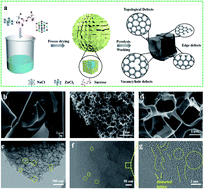Insight into the significant contribution of intrinsic carbon defects for the high-performance capacitive desalination of brackish water†
Abstract
Carbon-based electrodes have experienced great progress for capacitive desalination owning to their high conductivity and low cost. However, the fundamental issue of the origin of their capacitive activity is far from clarified. In particular, a systematic exploration of the influences of intrinsic defects ubiquitous in carbon on capacitive desalination is still a great challenge. Herein, porous carbons with different degrees of intrinsic defects were first designed via an effective dual-templating approach. The optimized carbon framework showed a high specific capacitance of 181 F g−1 at 2 mV s−1 in 1.0 M NaCl electrolyte. Moreover, it displayed a superb salt-adsorption capacity of 47.2 mg g−1 in 1000 mg L−1 NaCl solution at 1.2 V. The experimental results demonstrated that the abundant intrinsic carbon defects play crucial roles in the salt-adsorption capacity and rate capability, and can enable an exceptional electrical double-layer capacitance and facilitate the adsorption behavior of ions. Additionally, from density functional theory simulation results, we observed that abundant intrinsic defects in carbon can greatly promote the charge density redistribution, thereby enhancing the ion-adsorption ability. This work presents deep insights into defective carbon-based materials for further understanding the effects of intrinsic defects on the capacitive desalination performance.



 Please wait while we load your content...
Please wait while we load your content...